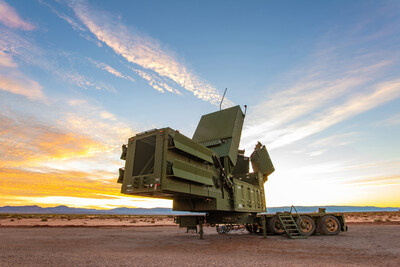RTX's Raytheon Lower Tier Air and Missile Defense Sensor detects and engages complex target
Live fire attended by military leaders from seven countries
WHITE SANDS MISSILE RANGE, N.M., March 21, 2024 /PRNewswire/ -- Raytheon, an RTX (NYSE: RTX) business, today announced that its Lower Tier Air and Missile Defense Sensor, or LTAMDS, continues to advance through its
This was the fourth live-fire demonstration for the advanced, 360-degree radar known as LTAMDS. The series of exercises, increasing in complexity, effectively demonstrate the radar's performance and integration with the Integrated Battle Command System, or IBCS. For this latest live fire, a cruise missile surrogate was launched, flying at high altitude, high speed and at a long range in an operational environment. LTAMDS acquired and tracked the target, passed track data to IBCS and LTAMDS guided a PAC-3 Missile Segment Enhancement (MSE) missile to intercept.
"The advanced capabilities of LTAMDS outpace the global threats of today and tomorrow and allied forces are watching its progress intently," said Tom Laliberty, president of Land & Air Defense Systems at Raytheon. "The solid performance of the radar against these complex and realistic threats validates the radar's design and demonstrates how this capability will transform the air and missile defense mission."
The program achieved significant developmental testing milestones in 2023, including the previous air breathing threat and ballistic missile live fires and the completion of CY23 contractor verification testing. Throughout, LTAMDS has met complex test objectives and demonstrated initial technical capability within its primary sector.
Six LTAMDS radars are currently progressing through full sector integration and test activities simultaneously at multiple government and Raytheon test sites. In 2024, rigorous testing will continue, leading up to fielding a 360-degree, full sector capability within the calendar year.
LTAMDS is the next generation air and missile defense radar for the
About Raytheon
Raytheon, an RTX business, is a leading provider of defense solutions to help the
About RTX
With more than 185,000 global employees, RTX pushes the limits of technology and science to redefine how we connect and protect our world. Through industry-leading businesses – Collins Aerospace, Pratt & Whitney, and Raytheon – we are advancing aviation, engineering integrated defense systems, and developing next-generation technology solutions and manufacturing to help global customers address their most critical challenges. The company, with 2023 sales of
For questions or to schedule an interview, please contact corporatepr@rtx.com
![]() View original content to download multimedia:https://www.prnewswire.com/news-releases/rtxs-raytheon-lower-tier-air-and-missile-defense-sensor-detects-and-engages-complex-target-302096102.html
View original content to download multimedia:https://www.prnewswire.com/news-releases/rtxs-raytheon-lower-tier-air-and-missile-defense-sensor-detects-and-engages-complex-target-302096102.html
SOURCE RTX









